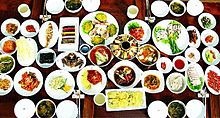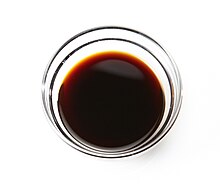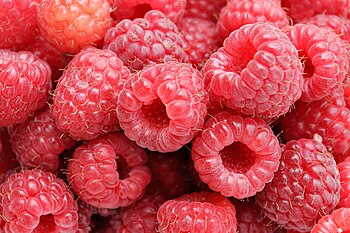Portal:Food
F o o d
A portal dedicated to food and foodways
Introduction


Food is any substance consumed by an organism for nutritional support. Food is usually of plant, animal, or fungal origin and contains essential nutrients such as carbohydrates, fats, proteins, vitamins, or minerals. The substance is ingested by an organism and assimilated by the organism's cells to provide energy, maintain life, or stimulate growth. Different species of animals have different feeding behaviours that satisfy the needs of their metabolisms and have evolved to fill a specific ecological niche within specific geographical contexts.
Omnivorous humans are highly adaptable and have adapted to obtain food in many different ecosystems. Humans generally use cooking to prepare food for consumption. The majority of the food energy required is supplied by the industrial food industry, which produces food through intensive agriculture and distributes it through complex food processing and food distribution systems. This system of conventional agriculture relies heavily on fossil fuels, which means that the food and agricultural systems are one of the major contributors to climate change, accounting for as much as 37% of total greenhouse gas emissions. (Full article...)
Cooking, also known as cookery or professionally as the culinary arts, is the art, science and craft of using heat to make food more palatable, digestible, nutritious, or safe. Cooking techniques and ingredients vary widely, from grilling food over an open fire, to using electric stoves, to baking in various types of ovens, reflecting local conditions. Cooking is an aspect of all human societies and a cultural universal.
Preparing food with heat or fire is an activity unique to humans. Archeological evidence of cooking fires from at least 300,000 years ago exists, but some estimate that humans started cooking up to 2 million years ago.
The expansion of agriculture, commerce, trade, and transportation between civilizations in different regions offered cooks many new ingredients. New inventions and technologies, such as the invention of pottery for holding and boiling of water, expanded cooking techniques. Some modern cooks apply advanced scientific techniques to food preparation to further enhance the flavor of the dish served. (Full article...)
Gibanica (Serbian Cyrillic: гибаница, pronounced [ˈɡibanit͡sa]) is a traditional pastry dish popular all over the Balkans. It is usually made with cottage cheese and eggs. Recipes can range from sweet to savoury, and from simple to festive and elaborate multi-layered cakes.
A derivative of the Serbo-Croatian verb gibati/гибати meaning "to fold; sway, swing, rock", the pastry was mentioned in Vuk Stefanović Karadžić's Serbian Dictionary in 1818 and by a Slovenian priest Jožef Kosič in 1828, where it was described as a special Slovenian cake which is "a must at wedding festivities and is also served to workers after finishing a big project". It is a type of layered strudel, a combination of Turkish and Austrian influences in different cuisines of the former Yugoslavia. Today the versions of this cake can be found in Slovenia, Croatia, Serbia, Bosnia, North Macedonia and other regions of the former Yugoslavia. Variants of this rich layered strudel are found in Hungary, Bulgaria, Greece, Turkey, and Syria. (Full article...)
Selected article –

Saffron (/ˈsæfrən, -rɒn/) is a spice derived from the flower of Crocus sativus, commonly known as the "saffron crocus". The vivid crimson stigma and styles, called threads, are collected and dried for use mainly as a seasoning and colouring agent in food. The saffron crocus was slowly propagated throughout much of Eurasia and was later brought to parts of North Africa, North America, and Oceania.
Saffron's taste and iodoform-like or hay-like fragrance result from the phytochemicals picrocrocin and safranal. It also contains a carotenoid pigment, crocin, which imparts a rich golden-yellow hue to dishes and textiles. Its recorded history is attested in a 7th-century BC Assyrian botanical treatise, and it has been traded and used for thousands of years. As of 2018, Iran produced some 88% of the world total for saffron. At US$5,000 per kg or higher, saffron has long been the world's costliest spice by weight. (Full article...)Selected cuisine -

Korean cuisine has evolved through centuries of social and political change. Originating from ancient agricultural and nomadic traditions in Korea and southern Manchuria, Korean cuisine reflects a complex interaction of the natural environment and different cultural trends.
Korean cuisine is largely based on rice, vegetables, seafood and (at least in South Korea) meats. Dairy is largely absent from the traditional Korean diet. Traditional Korean meals are named for the number of side dishes (반찬; 飯饌; banchan) that accompany steam-cooked short-grain rice. Kimchi is served at nearly every meal. Commonly used ingredients include sesame oil, doenjang (fermented bean paste), soy sauce, salt, garlic, ginger, gochugaru (pepper flakes), gochujang (fermented red chili paste) and napa cabbage. (Full article...)Selected ingredient –
Soy sauce (sometimes called soya sauce in British English) is a liquid condiment of Chinese origin, traditionally made from a fermented paste of soybeans, roasted grain, brine, and Aspergillus oryzae or Aspergillus sojae molds. It is recognized for its saltiness and pronounced umami taste.
Soy sauce was created in its current form about 2,200 years ago during the Western Han dynasty of ancient China. Since then, it has become an important ingredient in East and Southeast Asian cooking as well as a condiment worldwide. (Full article...)
Selected recipe –
Cornbread is a quick bread made with cornmeal, associated with the cuisine of the Southern United States, with origins in Native American cuisine. It is an example of batter bread. Dumplings and pancakes made with finely ground cornmeal are staple foods of the Hopi people in Arizona. The Hidatsa people of the Upper Midwest call baked cornbread naktsi. Cherokee and Seneca tribes enrich the basic batter, adding chestnuts, sunflower seeds, apples, or berries, and sometimes combine it with beans or potatoes. Modern versions of cornbread are usually leavened by baking powder. (Full article...)
Sweet Cornbread is a variant of the Skillet Cornbread made throughout the Southern United States.

Medieval cuisine includes foods, eating habits, and cooking methods of various European cultures during the Middle Ages, which lasted from the 5th to the 15th century. During this period, diets and cooking changed less than they did in the early modern period that followed, when those changes helped lay the foundations for modern European cuisines.
Cereals remained the most important staple during the Early Middle Ages as rice was introduced to Europe late, with the potato first used in the 16th century, and much later for the wider population. Barley, oats, and rye were eaten by the poor while wheat was generally more expensive. These were consumed as bread, porridge, gruel, and pasta by people of all classes. Cheese, fruits, and vegetables were important supplements for the lower orders while meat was more expensive and generally more prestigious. Game, a form of meat acquired from hunting, was common only on the nobility's tables. The most prevalent butcher's meats were pork, chicken, and other poultry. Beef, which required greater investment in land, was less common. A wide variety of freshwater and saltwater fish was also eaten, with cod and herring being mainstays among the northern populations. (Full article...)Selected image –
Selected biography –
B. 27 May 1975
Jamie Trevor Oliver MBE OSI (born 27 May 1975) is an English celebrity chef, restaurateur and cookbook author. He is known for his casual approach to cuisine, which has led him to front numerous television shows and open many restaurants.
Oliver reached the public eye when his series The Naked Chef premiered in 1999. In 2005, he opened a campaign, Feed Me Better, to introduce schoolchildren to healthier foods, which was later backed by the government. He was the owner of a restaurant chain, Jamie Oliver Restaurant Group, which opened its first restaurant, Jamie's Italian, in Oxford in 2008. The chain went into administration in May 2019. (Full article...)
Did you know (auto-generated) –

- ... that Tad's Steaks offered "tasty food, low prices, service with a grunt"?
- ... that the reactions to food depicted in the manga series Food Wars!: Shokugeki no Soma were decided on through free association games?
- ... that environmental activist Nigel Savage created Hazon after googling "Jewish food movement" and receiving zero search results?
- ... that the Sonoran blue butterfly uses Dudleya cymosa subsp. pumila as a larval foodplant and hummingbirds feed on its nectar?
- ... that the Korean stew budae-jjigae commonly includes baked beans, Spam, corn, and American cheese?
- ... that food psychology research has found that the COVID-19 pandemic led to both reduced and increased consumption of junk food among different geographical populations and educational backgrounds?
More did you know –
Related portals
Food topics
The following are topics relating to food
Categories
Food list articles
- See also: Lists of foods and Category:Lists of drinks
The following are some Food list articles on Wikipedia:

- American cheeses
- Appellation d'Origine Contrôlée cheeses
- Apple cultivars
- Bacon dishes
- Bacon substitutes
- Basil cultivars
- Breads
- Breakfast beverages
- Breakfast cereals
- Breakfast foods
- British cheeses
- Cakes
- Candies
- Cheeses
- Cheese soups
- Christmas dishes (list)
- Cocktails
- Cookies
- Dishes using coconut milk
- Diets
- Doughnut varieties
- Egg dishes
- Fermented soy products
- Food additives
- Food additives (Codex Alimentarius)
- Foods named after people
- French cheeses
- French dishes
- Fried dough foods
- Fruits
- List of hamburgers
- Herbs and spices
- Hors d'oeuvre
- Indian dishes
- Indian snack foods
- Indonesian dishes
- Italian dishes
- Japanese snacks
- Japanese dishes
- Jewish dishes
- Kebabs
- Korean beverages
- Mango cultivars
- Moroccan dishes
- Pasta
- Pastries
- Philippine snack food
- Pies, tarts and flans
- Poppy seed pastries and dishes
- Potato dishes
- Puddings
- Raw fish dishes
- Rice dishes
- Rolled foods
- Sauces
- Seafood
- Seeds
- Sandwiches
- Snack foods
- Soft drinks by country
- Soul foods and dishes
- Soups
- Stews
- Street foods
- Tapas
- Turkish dishes
- Twice-baked foods
- Vegetable oils
- Vegetables
- Vodkas
Things you can do
Related WikiProjects
| Parent project: WikiProject Food and Drink | |
| Child projects: | Task forces: (All inactive) |
|
|
| Related projects: | |
New articles
Rules | Match log | Results page (for watching) | Last updated: 2024-08-07 19:16 (UTC)
Note: The list display can now be customized by each user. See List display personalization for details.
- Higgitt's Las Vegas Arcade Blackpool & £1 Burger Bar (edit | talk | history | links | watch | logs | tools) by KatoKungLee (talk · contribs · new pages (5)) started on 2024-08-07, score: 10
- Brownstones Coffee (edit | talk | history | links | watch | logs | tools) by StonyBrook (talk · contribs · new pages (1)) started on 2024-08-07, score: 10
- Dashen Brewery Share Company Ltd (edit | talk | history | links | watch | logs | tools) by AsteriodX (talk · contribs · new pages (2)) started on 2024-08-07, score: 10
- Food Ethics (journal) (edit | talk | history | links | watch | logs | tools) by J Milburn (talk · contribs · new pages (6)) started on 2024-08-06, score: 10
- Lawrence Mumar (edit | talk | history | links | watch | logs | tools) by YssaLang (talk · contribs · new pages (70)) started on 2024-08-06, score: 10
- Gazoza (Prilep) (edit | talk | history | links | watch | logs | tools) by Direktorot (talk · contribs · new pages (1)) started on 2024-08-05, score: 10
- Leo Hirschfield (edit | talk | history | links | watch | logs | tools) by Nightscream (talk · contribs · new pages (1)) started on 2024-08-05, score: 20
- Hakrim Dabang (edit | talk | history | links | watch | logs | tools) by Seefooddiet (talk · contribs · new pages (22)) started on 2024-08-02, score: 10
- Bruce M. Nicol (edit | talk | history | links | watch | logs | tools) by WheelHelms WS (talk · contribs · new pages (4)) started on 2024-08-05, score: 10
- Mangifera caloneura (edit | talk | history | links | watch | logs | tools) by Tropwine (talk · contribs · new pages (4)) started on 2024-08-05, score: 10
- Brijesh K. Tiwari (edit | talk | history | links | watch | logs | tools) by Bernie Clay Bear (talk · contribs · new pages (1)) started on 2024-08-05, score: 10
- Bujurquina syspilus (edit | talk | history | links | watch | logs | tools) by Phil Fish (talk · contribs · new pages (27)) started on 2024-08-05, score: 10
- Furai (edit | talk | history | links | watch | logs | tools) by Arsene10 (talk · contribs · new pages (4)) started on 2024-08-05, score: 10
- Frutillada (edit | talk | history | links | watch | logs | tools) by JustEMV (talk · contribs · new pages (16)) started on 2024-08-04, score: 10
- Choco Togo (edit | talk | history | links | watch | logs | tools) by Yue (talk · contribs · new pages (17)) started on 2024-08-04, score: 10
- Pariolius armillatus (edit | talk | history | links | watch | logs | tools) by Big Blue Cray(fish) Twins (talk · contribs · new pages (14)) started on 2024-08-04, score: 10
- Tamari Bar (edit | talk | history | links | watch | logs | tools) by Another Believer (talk · contribs · new pages (44)) started on 2024-07-31, score: 10
- Lexington Barbecue (edit | talk | history | links | watch | logs | tools) by Another Believer (talk · contribs · new pages (44)) started on 2024-08-04, score: 10
- Jeon Ha-young (edit | talk | history | links | watch | logs | tools) by Adamtt9 (talk · contribs · new pages (94)) started on 2024-08-03, score: 10
- Ambpoeial (edit | talk | history | links | watch | logs | tools) by Hangshangs (talk · contribs · new pages (2)) started on 2024-08-03, score: 30
- Adriano Go (edit | talk | history | links | watch | logs | tools) by YssaLang (talk · contribs · new pages (70)) started on 2024-08-03, score: 10
- Premna microphylla (edit | talk | history | links | watch | logs | tools) by Awkwafaba (talk · contribs · new pages (111)) started on 2024-08-02, score: 10
- Hutaoli (edit | talk | history | links | watch | logs | tools) by AirQuinn (talk · contribs · new pages (2)) started on 2024-08-02, score: 10
- Poinpy (edit | talk | history | links | watch | logs | tools) by Gisrhgver (talk · contribs · new pages (2)) started on 2024-08-01, score: 20
- Coat of arms of Sudbury (edit | talk | history | links | watch | logs | tools) by WikiPhil012 (talk · contribs · new pages (6)) started on 2024-08-01, score: 10
- Chin Mee Chin Confectionery (edit | talk | history | links | watch | logs | tools) by Imbluey2 (talk · contribs · new pages (10)) started on 2024-08-01, score: 10
- Heinrich Bennecke (edit | talk | history | links | watch | logs | tools) by Historybuff0105 (talk · contribs · new pages (8)) started on 2024-07-31, score: 10
- Sudhir Sastry (edit | talk | history | links | watch | logs | tools) by HRShami (talk · contribs · new pages (13)) started on 2024-07-31, score: 10
- Izze (drink) (edit | talk | history | links | watch | logs | tools) by Atubofsilverware (talk · contribs · new pages (5)) started on 2024-07-31, score: 30
- Carmona Wine Urn (edit | talk | history | links | watch | logs | tools) by NeverBeGameOver (talk · contribs · new pages (4)) started on 2024-07-31, score: 10
- Moisés Gómez (baseball) (edit | talk | history | links | watch | logs | tools) by Stonecold415 (talk · contribs · new pages (11)) started on 2024-07-31, score: 10
- Thiere (edit | talk | history | links | watch | logs | tools) by Monomi0 (talk · contribs · new pages (2)) started on 2024-07-30, score: 10
- Quest Nutrition (edit | talk | history | links | watch | logs | tools) by BanjoZebra (talk · contribs · new pages (6)) started on 2024-07-19, score: 20
- Food shaming (edit | talk | history | links | watch | logs | tools) by GobsPint (talk · contribs · new pages (9)) started on 2024-07-30, score: 10
- Tottiford, Kennick, and Trenchford Reservoirs (edit | talk | history | links | watch | logs | tools) by Owain.davies (talk · contribs · new pages (9)) started on 2024-07-29, score: 10
- Bryan Sammons (edit | talk | history | links | watch | logs | tools) by Muboshgu (talk · contribs · new pages (11)) started on 2024-07-29, score: 10
- Masterfoods (edit | talk | history | links | watch | logs | tools) by Pidzz (talk · contribs · new pages (10)) started on 2024-07-29, score: 40
- Hydrox Corporation (edit | talk | history | links | watch | logs | tools) by Bluethricecreamman (talk · contribs · new pages (4)) started on 2024-07-29, score: 30
- Marmelada de Santa Luzia (edit | talk | history | links | watch | logs | tools) by BaduFerreira (talk · contribs · new pages (3)) started on 2024-07-28, score: 30
- Mangifera applanata (edit | talk | history | links | watch | logs | tools) by Tropwine (talk · contribs · new pages (4)) started on 2024-07-28, score: 10
- Avec (restaurant) (edit | talk | history | links | watch | logs | tools) by Another Believer (talk · contribs · new pages (44)) started on 2024-07-26, score: 10
- Oh Seung-hoon (curler) (edit | talk | history | links | watch | logs | tools) by TracyFleuryFan (talk · contribs · new pages (12)) started on 2024-07-27, score: 10
- Neary's (edit | talk | history | links | watch | logs | tools) by Voorts (talk · contribs · new pages (27)) started on 2024-07-27, score: 10
- Phin (restaurant) (edit | talk | history | links | watch | logs | tools) by Another Believer (talk · contribs · new pages (44)) started on 2024-07-27, score: 10
- Parliamentary Under-Secretary of State for Nature (edit | talk | history | links | watch | logs | tools) by THeShavidow1 (talk · contribs · new pages (1)) started on 2024-07-27, score: 10
- T. B. Robson (edit | talk | history | links | watch | logs | tools) by Doug butler (talk · contribs · new pages (12)) started on 2024-07-27, score: 10
- Nepal Foods (edit | talk | history | links | watch | logs | tools) by HibaShaikh (talk · contribs · new pages (1)) started on 2024-07-27, score: 10
- Analog Coffee (edit | talk | history | links | watch | logs | tools) by Another Believer (talk · contribs · new pages (44)) started on 2024-07-27, score: 10
- The Green Tree Distillery (edit | talk | history | links | watch | logs | tools) by MonikaKubasakova (talk · contribs · new pages (1)) started on 2024-07-27, score: 10
- Café Hagen (edit | talk | history | links | watch | logs | tools) by Another Believer (talk · contribs · new pages (44)) started on 2024-07-23, score: 10
- Mannion v. Coors Brewing Co. (edit | talk | history | links | watch | logs | tools) by Daniel Case (talk · contribs · new pages (7)) started on 2024-07-25, score: 10
- Meldon Reservoir (edit | talk | history | links | watch | logs | tools) by Owain.davies (talk · contribs · new pages (9)) started on 2024-07-24, score: 10
- Pendennis Club (cocktail) (edit | talk | history | links | watch | logs | tools) by Nbarth (talk · contribs · new pages (5)) started on 2024-07-24, score: 10
- Lewis Orford (footballer) (edit | talk | history | links | watch | logs | tools) by 86.18.110.36 (talk · contribs · new pages (1)) started on 2024-07-24, score: 10
Associated Wikimedia
The following Wikimedia Foundation sister projects provide more on this subject:
-
Commons
Free media repository -
Wikibooks
Free textbooks and manuals -
Wikidata
Free knowledge base -
Wikinews
Free-content news -
Wikiquote
Collection of quotations -
Wikisource
Free-content library -
Wikiversity
Free learning tools -
Wiktionary
Dictionary and thesaurus
















































